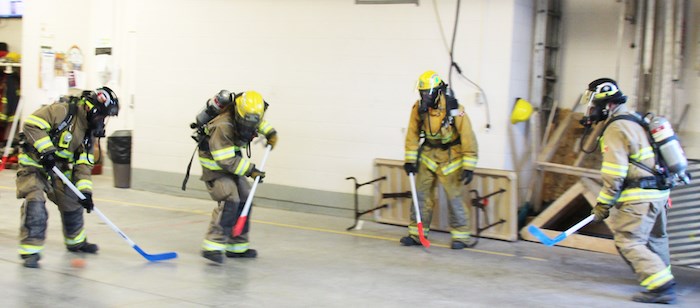
Joanne McQuarrie, Local Journalism Initiative Reporter | [email protected]
When Jasper Fire Department members play floor hockey, the match is more than a friendly sporting get-together.
In full gear - about 25 kilograms of it, including a jacket, pants, boots, helmet, gloves and a self contained breathing apparatus (SCBA) with a mask - the firefighters run, jostle each other and shoot the puck in the net, an overturned table.
"The point of playing hockey, or soccer or basketball," said Amy West, assistant fire chief, "is it gets their heart rates to a similar status it would be at when they're actioning a fire, pulling hoses, working with tools.
"So what their responsibility is, is to watch their air supply, keep track of the air supply."
Air management is an integral skill to have when you're in the middle of an intense scenario.
In the practices, once the firefighters have used a certain amount of their air, they have to go through a scenario where they need to communicate.
In a real-life situation, West said, "You're out of breath, in a high stress environment, and you have to think about how you're going to react and what you're going to communicate to your team members or the incident commander - what your situation is, and what you need for assistance or resources."
She added: "When we're inside of a building we have to be aware of how much air we're using.”
The plan, West said, is to have an idea of your own consumption rate, and your partner's capability.
“Remember how much air it took to get in, in the first place,” she said. “If there's less than 50 per cent, it's time to get out.”

Before the pandemic was declared, firefighter training sessions were held once a week.
Now, in alliance with social distancing and other COVID protocol, the Jasper firefighting team has been segmented into three groups with about 10 to 12 people each, West said.
They attend one of three sessions held weekly for two or three hours each time, each with the same focus.
In addition to air management, there is training for vehicle extrication, vehicle fires, some pumping operations and medical-related emergencies, because, West said, it's not just fires the team responds to. They are also called to rescues, medicals, and other emergencies.
Wearing the gear, carrying an SCBA on your back, hauling hoses and more requires a high level of stamina.
Each year members go through a physical fitness test, starting on a treadmill, and going through six stations of firefighting-related skills.
All of this is "to make sure we're physically fit to do what is expected on a call", West said. "Everyone does the physical fitness test. When you join, you've got to be able to do this test."
Virtual FireSmart
Educating the public is an important undertaking of the Jasper Fire Department.
A video created by West, Jasper Community FireSmart 2020, was released on the municipality's website on Sept. 3.
"Typically we hold open houses to educate people about fire protection and reducing the risk of ignition, and also community-driven work bees, led by the fire department," West said.
But due to the pandemic, the department had to look for different ways to engage the community.
One of the things West and fire chief Greg Van Tighem came up with was a virtual information video which describes Jasper being in a Wildland-Urban Interface (WUI) environment, and the risks about being in such an area.
The Municipality of Jasper and Parks Canada have collaborated on work to reduce the risk around the perimeter of town, including removing forest fuels.
In the video, West emphasizes the importance of homeowners in town taking initiatives to reduce risks as well.
Solving the wildfire threat in Jasper, she said, depends very much on what happens before the fire occurs and what happens in our own backyards.
"The biggest point is what Jasper residents can do in and around their homes to reduce the risk of fire," West said.
Jasper has local FireSmart representatives and residents can phone the fire department to chat with someone, or learn virtually about measures to take. They can do house calls too.
West said: "If people want assistance we can send people out to the residence to do an assessment, look at everything on your home from top to bottom: siding, gutters, eaves. The goal is to make your house less vulnerable and more fire resistant."
That means removing unnecessary fuels in your yard. "Mulch is a big one," West noted.
She pointed out that the loss of most homes in fires is due to flying embers.
"Embers can travel several kilometres from the site of the fire," she said. “Having a tin roof or asphalt shingles reduces that risk."
In the video are aerial photos of two homes surrounded by burned forest but still in good shape following the fire, because they followed FireSmart guidelines.
Watch the video online at www.youtube.com/watch?v=qIq_9uQw0Vk.



